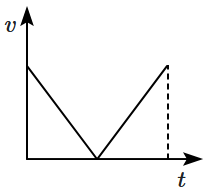Select Question Set:
The ratio of the distances travelled by a freely falling body in the \(1\)st, \(2\)nd, \(3\)rd and \(4\)th second is:
1.
\(1:1:1:1\)
2.
\(1:2:3:4\)
3.
\(1:4:9:16\)
4.
\(1:3:5:7\)
Subtopic: Uniformly Accelerated Motion |
81%
Level 1: 80%+
NEET - 2022
Hints
Given below are two statements:
| Assertion (A): | A body is momentarily at rest at the instant it reverses the direction. |
| Reason (R): | A body cannot have acceleration if its velocity is zero at a given instant of time. |
| 1. | Both (A) and (R) are True and (R) is the correct explanation of (A). |
| 2. | Both (A) and (R) are True but (R) is not the correct explanation of (A). |
| 3. | (A) is True but (R) is False. |
| 4. | (A) is False but (R) is True. |
Subtopic: Instantaneous Speed & Instantaneous Velocity |
67%
Level 2: 60%+
Please attempt this question first.
Hints
Please attempt this question first.
A stone is thrown vertically downwards with an initial velocity of \(40\) m/s from the top of a building. If it reaches the ground with a velocity of \(60\) m/s, then the height of the building is: (take \(g=10\) m/s2)
| 1. | \(120\) m | 2. | \(140\) m |
| 3. | \(80\) m | 4. | \(100\) m |
Subtopic: Uniformly Accelerated Motion |
85%
Level 1: 80%+
NEET - 2022
Hints
The figure given below shows the displacement and time, \((x\text -t)\) graph of a particle moving along a straight line:
The correct statement, about the motion of the particle, is:
| 1. | the particle moves at a constant velocity up to a time \(t_0\) and then stops. |
| 2. | the particle is accelerated throughout its motion. |
| 3. | the particle is accelerated continuously for time \(t_0\) then moves with constant velocity. |
| 4. | the particle is at rest. |
Subtopic: Graphs |
77%
Level 2: 60%+
NEET - 2022
Hints
Given below are two statements:
| Assertion (A): | Two balls of different masses are thrown vertically upward with the same speed. They will pass through their point of projection in the downward direction with the same speed. |
| Reason (R): | The maximum height and downward velocity attained at the point of projection are independent of the mass of the ball. |
| 1. | Both (A) and (R) are True and (R) is the correct explanation of (A). |
| 2. | Both (A) and (R) are True but (R) is not the correct explanation of (A). |
| 3. | (A) is True but (R) is False. |
| 4. | Both (A) and (R) are False. |
Subtopic: Uniformly Accelerated Motion |
80%
Level 1: 80%+
Hints
A particle moves along a straight line with its velocity \((v)\) varying as the square root of its displacement \((x)\text:\) \(v\propto\sqrt x\)
Then its acceleration varies as:
1. \(\dfrac{1}{\sqrt x}\)
2. \(x^{3/2}\)
3. \(x^{-3/2}\)
4. \(x^0\)
Then its acceleration varies as:
1. \(\dfrac{1}{\sqrt x}\)
2. \(x^{3/2}\)
3. \(x^{-3/2}\)
4. \(x^0\)
Subtopic: Acceleration |
57%
Level 3: 35%-60%
Please attempt this question first.
Hints
Please attempt this question first.
A car, which is initially stationary, accelerates for
\(5\) s at \(4.0\) m/s2 along a straight road. It then continues in the same direction for \(20\) s at a constant speed. What is the maximum speed of the car, and what is the distance travelled by the car in the final \(20\) s of its motion?
\(5\) s at \(4.0\) m/s2 along a straight road. It then continues in the same direction for \(20\) s at a constant speed. What is the maximum speed of the car, and what is the distance travelled by the car in the final \(20\) s of its motion?
| 1. | maximum speed = \(24\) m/s; distance = \(480\) m |
| 2. | maximum speed = \(20\) m/s; distance = \(400\) m |
| 3. | maximum speed = \(9.0\) m/s; distance = \(200\) m |
| 4. | maximum speed = \(9.0\) m/s; distance = \(180\) m |
Subtopic: Uniformly Accelerated Motion |
82%
Level 1: 80%+
Please attempt this question first.
Hints
Please attempt this question first.
A ball is thrown vertically upward with a certain velocity from the surface of the earth and after some time it returns back to the earth. The velocity-time (\(v\text-t\)) graph for the entire journey is given by:
| 1. |  |
2. |  |
| 3. |  |
4. |  |
Subtopic: Graphs |
58%
Level 3: 35%-60%
Please attempt this question first.
Hints
Please attempt this question first.
The position-time \((x\text-t)\) graph for positive acceleration is:
| 1. |  |
2. |  |
| 3. |  |
4. |  |
Subtopic: Graphs |
81%
Level 1: 80%+
NEET - 2022
Hints
A car travels a distance \(AB\) in three equal segments: the first third at a velocity of \(v_1~\text{m/s},\) the second third at \(v_2~\text{m/s},\) and the final third at \(v_3~\text{m/s}.\) Given that \(v_3 = 3v_1 , ~v_2 = 2v_1\) and \(v_1 = 11~\text{m/s} ,\) the average velocity of the car is:


| 1. | \(12~\text{m/s}\) | 2. | \(18~\text{m/s}\) |
| 3. | \(16~\text{m/s}\) | 4. | \(11~\text{m/s}\) |
Subtopic: Average Speed & Average Velocity |
76%
Level 2: 60%+
JEE
Please attempt this question first.
Hints
Please attempt this question first.
Select Question Set:







